|
|
|
Sort Order |
|
|
|
Items / Page
|
|
|
|
|
|
|
| Srl | Item |
| 1 |
ID:
107461
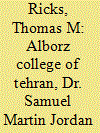

|
|
|
|
|
| Publication |
2011.
|
| Summary/Abstract |
The article addresses the twentieth-century social and cultural history of Alborz College (The American College of Tehran) in terms of its curricula, mission education, the faculty and Dr. Samuel Jordan, founder and president. The courses taught, from the natural sciences and humanities to business and journalism, shaped the lives and aspirations of so many of the graduates for decades. Of great importance were the academic training and personal lives of Dr. Jordan, Mary Park Jordan, and the American faculty, particularly those graduates from Lafayette College (Easton, Pennsylvania) who served as role models of modernity and generous public service that so enriched the lives of their young Iranian charges and won the hearts and minds of the Alborzi graduates.
|
|
|
|
|
|
|
|
|
|
|
|
|
|
|
|
| 2 |
ID:
107459
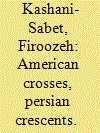

|
|
|
|
|
| Publication |
2011.
|
| Summary/Abstract |
The American public came to know Iran through its missionaries who had lived among the Persians. For their part, Iranians grew familiar with Americans through interactions with these missionary pioneers as well. While American Presbyterians quickly established and expanded their institutional presence in the country, it became abundantly clear to them that Muslim converts to Protestantism remained few and far between. Missionary perceptions of Iranian Muslims, however, left an indelible imprint on American public understanding of Iran and its people. The paper argues that religious ideology frequently colored perceptions and influenced policy-making. Even after more than a hundred years of interaction, cultural representations were refracted through religious difference and similarity. Despite the increasingly secular cultures of Iran and America in the early twentieth century, religion remained a salient ideology for the public in both societies-one that has had a profound impact on the nature of US-Iranian relations. Thus, it is important to analyze the origins and impact of this contact beginning in the nineteenth century.
|
|
|
|
|
|
|
|
|
|
|
|
|
|
|
|
| 3 |
ID:
168983
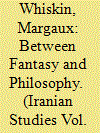

|
|
|
|
|
| Summary/Abstract |
Zadig ou la Destinée opens on a preface supposedly written by Sadi (sic), who seems to suggest he is the translator of the story which is to follow. The article will investigate the role played by Voltaire’s reference to Saʿdi in Zadig as an Oriental prop for the narrative’s exotic setting, but also, more importantly, as participating in its philosophical content. Travelers’ accounts had brought growing interest in Persia, and Saʿdi would not have been unfamiliar to an educated public; the Orient more generally became an experimental space for Enlightenment thought. Playing on the notion of the translator as cultural bridge, the article examines the uses Voltaire makes of Saʿdi in Zadig and whether these correlate to the eighteenth-century French reader’s perceptions of the Iranian poet.
|
|
|
|
|
|
|
|
|
|
|
|
|
|
|
|
| 4 |
ID:
130602
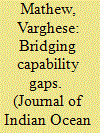

|
|
|
|
|
| Publication |
2014.
|
| Summary/Abstract |
Whoever controls the Indian Ocean, dominates Asia. This Ocean is the key to seven seas. In the 215'' century, the fate of the world would be decided on its waters".
Admiral Alfred Thayer Mahan
Indian Ocean is the third largest of the world's oceanic divisions. ; The world's earliest civilisations in Mesopotamia, ancient Egypt, the ' Indian subcontinent, Persia and later in Southeast Asia, all developed around the Indian Ocean. Today its littorals and hinterland comprises more than fifty nation states and two-thirds of the world's known reserves of strategic raw materials while an estimated 40 °/o of the world's offshore oil production comes from it.2 The Oceans have been historically the arenas for contest between maritime powers.
|
|
|
|
|
|
|
|
|
|
|
|
|
|
|
|
| 5 |
ID:
129007
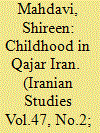

|
|
|
|
|
| Publication |
2014.
|
| Summary/Abstract |
The history of children in general and that of Persian children in particular is that of the inarticulate. The social history of Iran is a neglected field although in recent decades a preponderance of material has appeared on the history of women. Aside from this no work has been undertaken on the private life of the period including childhood and family life. This article examines various aspects of the position and upbringing of children in Qajar Iran ranging from the rearing of children to their status in the family, discipline, amusements and education. This investigation attempts to cover the childhood of different sexes and social classes both in rural and urban areas. The discussion is limited to Shi'i children, the majority population of Iran.
|
|
|
|
|
|
|
|
|
|
|
|
|
|
|
|
| 6 |
ID:
129010
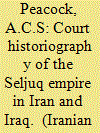

|
|
|
|
|
| Publication |
2014.
|
| Summary/Abstract |
This paper reexamines the Arabic and Persian historical literature of the Seljuq period (1040-1194), concentrating on works produced in circles connected with the sultanic court. It considers the relationship between the Arabic and Persian works, the authors' motives for composition, and the reasons for choice of language. It also compares these works with their predecessors, especially the historiography of the Ghaznavid court, with a view to assessing the particular characteristics of Seljuq historical writing, which is often considered rather slight and unimpressive. One reason that is often adduced for this is the absence of dynastic history writing under the Seljuqs, and the alleged lack of interest of the Seljuq court in patronizing historiography, themes which we also investigate here.
|
|
|
|
|
|
|
|
|
|
|
|
|
|
|
|
| 7 |
ID:
087950
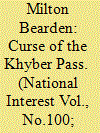

|
|
|
|
|
| Publication |
2009.
|
| Summary/Abstract |
AS THE United States settles into its eighth year of military operations in Afghanistan, and as plans for ramping up U.S. troop strength are under way, we might reflect on an observation made by the Chinese military sage, Sun Tzu, about twenty-five hundred years ago:
In military campaigns I have heard of awkward speed but have never seen any skill in lengthy campaigns. No country has ever profited from protracted warfare.
These words tell the tale of the string of superpowers that have found themselves drawn into a fight in the inhospitable terrain we now call Afghanistan. Their stories of easy conquest followed by unyielding rebellion are hauntingly similar, from the earliest accounts of Alexander's Afghan campaign, when, in 329 BC, the great warrior found the struggle longer, more brutal and more costly than his battle in Persia. And through six centuries the Mughals never managed to bring the Afghans to heel, and most certainly not the Pashtuns. Of course, there were also the disastrous expeditions of Britain and the Soviet Union. Now it is up to the Obama administration to try to change the long odds in what will become America's longest war.
|
|
|
|
|
|
|
|
|
|
|
|
|
|
|
|
| 8 |
ID:
129004
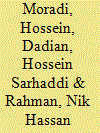

|
|
|
|
|
| Publication |
2014.
|
| Summary/Abstract |
This paper consists of some of the findings of the authors during their research at prehistoric sites of Bampur and its surrounding areas in August 2011. These areas, which have been introduced as Bampur-related sites, comprise an area about of 5-10 kilometers and belong to the Bronze Age. The paper introduces, categorizes and analyzes the archaeological findings in relation to the Bampur collection. The archaeological findings show that: (1) unlike the previous belief, there existed a peak settlement dated back to the Chah Husseini period which was prior to Bampur I; (2) in fact, Bampur II-IV had larger populations due to growth of trade and commerce and their relations with Yahya and Mesopotamia; (3) the later periods of the Bampur collection show a decreasing number of sites at Bampur VI.
|
|
|
|
|
|
|
|
|
|
|
|
|
|
|
|
| 9 |
ID:
125968


|
|
|
|
|
| Publication |
2013.
|
| Summary/Abstract |
After Issus (333 BC), Alexander took possession of Syria and the Levant coast. The next year he attacked Tyre, a rich and strategic Phoenician port and its largest city-state. Tyre was the only Persian port that had not capitulated. Even this far into the war, the Persian navy still posed a threat. Tyre was located both on the Mediterranean coast and an island with two natural harbours. Alexander built a causeway to allow his army to take the town by land. This engineering feat showed the true extent of his brilliance: he built a kilometer-long causeway on a natural land bridge no more than two metres deep. He then constructed two towers 150-feet high at the end of the causeway. The Tyrians, however, quickly counterattacked. They filled an old transport ship with wood, pitch, sulphur and other combustibles, lit it on fire creating a primitive form of napalm, and ran it up onto the causeway, which was engulfed by the flames.
|
|
|
|
|
|
|
|
|
|
|
|
|
|
|
|
| 10 |
ID:
116320
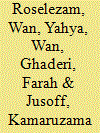

|
|
|
|
|
| Publication |
2012.
|
| Summary/Abstract |
Isabella Bird Bishop's Journeys in Persia and Kurdistan is presented as an objective picture of Persia, purportedly reflecting eye-witness accounts. Setting the narrative in its historical context and employing the concept of exoticism, this paper aims to unearth its subtle imperialist underpinnings. It argues that Bird's portrayal of Persian women and their mores and manners as exotic is an effect of a mode of representation which depicts and constructs difference based on a British-oriented system of evaluation, in line with its imperialist interest in Persia. As such, the exotic representation of Persian women in need of British benign tutelage and a chivalric mission could be interpreted as lending implicit support to Britain's colonial intervention in and imposition on Persia.
|
|
|
|
|
|
|
|
|
|
|
|
|
|
|
|
| 11 |
ID:
155115
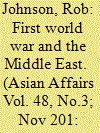

|
|
|
|
|
| Summary/Abstract |
The First World War in the Middle East swept away five hundred years of Ottoman dominion. It ushered in new ideologies and radicalized old ones – from Arab nationalism and revolutionary socialism to impassioned forms of atavistic Islamism. It created heroic icons, like the enigmatic Lawrence or the modernizing Atatürk, and it completely re-drew the map of the region, forging a host of new nation states, For many, the self-serving intervention of these powers in the region between 1914 and 1919 is the major reason for the conflicts that have raged there on and off ever since. Yet many of the most common assertions about the First World War in the Middle East and its aftermath are devoid of context. This article argues that, far from being a mere sideshow to the war in Europe, the Middle Eastern conflict was in fact the centre of gravity in a war for imperial interests. Moreover, contrary to another persistent myth of the First World War in the Middle East, local leaders and their forces were not simply the puppets of the Great Powers. The way in which these local forces embraced, resisted, succumbed to, disrupted, or on occasion overturned the plans of the imperialist powers for their own interests in fact played an important role in shaping the immediate aftermath of the conflict – and in laying the foundations for the troubled Middle East.
|
|
|
|
|
|
|
|
|
|
|
|
|
|
|
|
| 12 |
ID:
182831
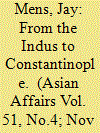

|
|
|
|
|
| Summary/Abstract |
This article argues that Napoleon Bonaparte's attempt to reach India, firstly through Egypt and then through Qajar Persia, inaugurated the ‘Middle East' as a coherent political space in international politics. The ostensibly existential threat posed by French schemes to British dominion over India prompted British Indian officials to perceive Egypt, Persia and the Gulf Emirates through the lens of Indian defence and European geopolitics for the first time. By the end of this period, these lands were imagined as a salient, somewhat coherent political space between “the Indus and Constantinople”. This first ‘Middle East’ was the product of the globalization of European geopolitics and the need to defend British India, auguring the future of the region, in which its political importance, and even its location, was constructed in relation to the broader context of international affairs.
|
|
|
|
|
|
|
|
|
|
|
|
|
|
|
|
| 13 |
ID:
081300
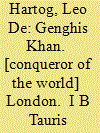

|
|
|
|
|
| Publication |
London, I B Tauris Publishers, 1999.
|
| Description |
ix, 230p.: mapsPbk
|
| Contents |
Includes bibliography, index.
|
| Standard Number |
1860643752
|
|
|
|
|
|
|
|
|
|
|
|
Copies: C:1/I:0,R:0,Q:0
Circulation
| Accession# | Call# | Current Location | Status | Policy | Location |
| 043093 | 923.1/HAR 043093 | Main | On Shelf | General | |
|
|
|
|
| 14 |
ID:
122628


|
|
|
| 15 |
ID:
120858
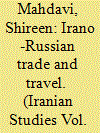

|
|
|
|
|
| Publication |
2013.
|
| Summary/Abstract |
Contacts between Russians and Persians have a long history going back to 1592 during the reign of the Safavid dynasty (1501-1736). However, the impact of Russia upon Persia was only felt as a result of military defeats in 1813 and 1828. In nineteenth century Persia there were many geographical obstacles which prevented foreigners including Russians from trading with Persia. This situation changed with the Treaty of Turkmanchai and its commercial protocol which gave Russian merchants special benefits and advantages. Consequently, by the 1860s Russian steamships started postal, passenger and cargo service from Baku to Persian Caspian ports and railheads advanced through the Caucasus to Tiflis. Persia traded with Russia on a much larger scale than with any other country. One of the Persian merchants who traded extensively with or through Russia to Europe was Haj Muhammad Hassan Amin al-Zarb (1834-98), the most prominent merchant of his time, and subsequently his son Haj Husayn Aqa Amin al-Zarb II. The article discusses Amin al-Zarb's trade and relations with Russia based upon unpublished material in the Amin al-Zarb archives in Tehran.
|
|
|
|
|
|
|
|
|
|
|
|
|
|
|
|
| 16 |
ID:
102709


|
|
|
|
|
| Publication |
2011.
|
| Summary/Abstract |
Isabella Bird Bishop was one of the remarkable Victorian women who traveled independently in both Persia and the neighboring countries of the Ottoman Empire. She came to Persia as a very experienced and respected travel writer who had journeyed alone and adventurously in the Americas, Australia, Japan and Malaya. Her travels in Persia in 1890 were possibly the hardest and most challenging of her life. She meticulously observed, recorded and finally published all that she saw-the terrain, meetings with the Qajar court, Bakhtiari and Kurdish tribal chiefs and the families, and the daily life and customs of the people.
|
|
|
|
|
|
|
|
|
|
|
|
|
|
|
|
| 17 |
ID:
153008
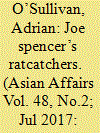

|
|
|
|
|
| Summary/Abstract |
During the Anglo-Soviet occupation of Persia (Iran), the Tehran-based Defence Security Office was responsible for protecting from Nazi subversion and sabotage three potential strategic targets: the vital oilfields, pipelines, and refineries of Khuzistan; the Lend-Lease supply route between the Persian Gulf and the Soviet Union; and the security of the Persian polity itself. Against all odds, under the command of Lt Col E.L. ‘Joe’ Spencer, this small but effective British/Indian security-intelligence unit succeeded in neutralising the Nazi threat, in capturing all German operatives on Persian soil, and in maintaining the security of a territory five times the size of Britain.
|
|
|
|
|
|
|
|
|
|
|
|
|
|
|
|
| 18 |
ID:
135089
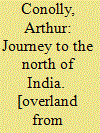

|
|
|
|
|
| Edition |
2nd rev.ed.
|
| Publication |
New Delhi, Asian educational services, 2001.
|
| Description |
2vol.set; 350p., 358p.Hbk
|
| Contents |
Vol I and Vol II, Old Publication
|
| Standard Number |
812061589X
|
|
|
|
|
|
|
|
|
|
|
|
Copies: C:2/I:0,R:0,Q:0
Circulation
| Accession# | Call# | Current Location | Status | Policy | Location |
| 057981 | 915.4/CON 057981 | Main | On Shelf | General | |
| 057982 | 915.4/CON 057982 | Main | On Shelf | General | |
|
|
|
|
| 19 |
ID:
124458
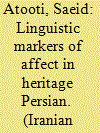

|
|
|
|
|
| Publication |
2013.
|
| Summary/Abstract |
By analyzing linguistic utterances between teachers and students in a Persian heritage language class in the United States, this research study sought to illuminate what kinds of linguistic resources were used by these speakers to show different attitudes, moods and emotions. Furthermore, this study demonstrated possible functions of these linguistic markers and the way they were utilized to influence another party.
|
|
|
|
|
|
|
|
|
|
|
|
|
|
|
|
| 20 |
ID:
051354
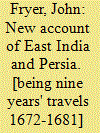

|
|
|
|
|
| Publication |
New Delhi, Asian educational services, 1992.
|
| Description |
3v. (xxxviii, 353p.;vi, 371p.; viii, 271p.)Hbk
|
| Contents |
3vol. Set.
|
| Standard Number |
8120607961
|
|
|
|
|
|
|
|
|
|
|
|
Copies: C:3/I:0,R:0,Q:0
Circulation
| Accession# | Call# | Current Location | Status | Policy | Location |
| 048070 | 915.404258/FRY 048070 | Main | On Shelf | General | |
| 048071 | 915.404258/FRY 048071 | Main | On Shelf | General | |
| 048072 | 915.404258/FRY 048072 | Main | On Shelf | General | |
|
|
|
|
|
|
|
|
|